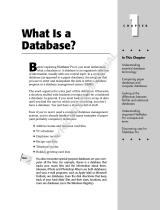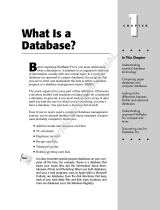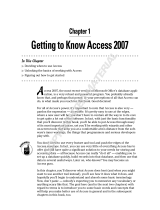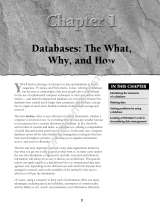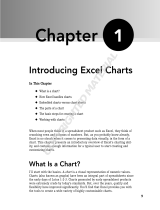
Chapter 1 | Introducing FileMaker Pro 11
Protecting databases
You can restrict what users see and do in a database file by defining accounts and privilege sets.
Accounts authenticate users who are attempting to open a protected file. Each account specifies
an account name and (usually) a password. Any user that cannot specify valid account information
won’t be able to open a protected file. A privilege set specifies a level of access to a database file.
Each account is assigned a privilege set, which determines the level of access when someone
opens a file using that account.
Extended privileges determine the data sharing options that are permitted by a privilege set, such
as whether a privilege set permits users to open a shared file or view a database in a web browser.
You can further protect a file by authorizing other FileMaker Pro files to create references to the
schema (tables, layouts, scripts, and value lists) in that file.
For more information about FileMaker Pro database security, see chapter 6, “Protecting databases.”
Creating scripts to automate tasks
Scripts can do simple tasks like setting print orientation or complex tasks like preparing a
customized mailing to customers.
For example, you could define a script that creates a thank you letter to customers in your
database who have made a purchase in the last week. The script composes a letter customized
to each customer. The script then switches to Preview mode and pauses so that you can see what
the letter looks like before it prints. The whole task is started by clicking a button on a layout.
You can build scripts by selecting from a list of FileMaker Pro script steps, specifying options, and
arranging the steps in the correct order to perform the task. FileMaker
Pro makes it easy to
manage and maintain scripts, even for complex databases. You can simultaneously view, edit, and
manage scripts from different databases. For more information about scripts, see
“Automating
tasks with scripts” on page 48.
You can also set up script triggers to specify that scripts run when particular events occur. For
more information, see Help.
Sharing and exchanging data
A benefit of storing data in FileMaker Pro is sharing your data with others. You can share your data
with other FileMaker
Pro or FileMaker Go users on a network, use the web publishing capabilities
to share data over the web, or import or export data from another file. In addition, you can use
ODBC (Open Database Connectivity) and JDBC (Java Database Connectivity) to share
FileMaker
Pro files with ODBC- and JDBC-compliant applications, or you can access data from
external data sources.
If your computer is connected to a network, you and other Windows and Mac OS FileMaker Pro
or FileMaker
Go users can use the same FileMaker Pro database file simultaneously.
FileMaker
Pro Network Sharing supports the sharing of files with up to nine concurrent users.
Note If you need to share files with more than nine concurrent users on a network, FileMaker
recommends the use of FileMaker
Server.
You can set up a FileMaker Pro file to automatically update data imported from another application
such as Microsoft Excel. Recurring import occurs automatically the first time you view the layout
containing the data from the external file. Later, you can run a script to update data. For more
information about recurring import, see
“Setting up recurring imports” on page 121.






















